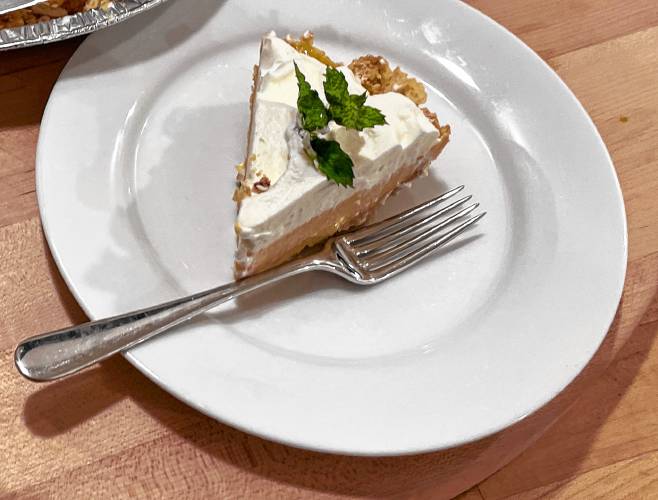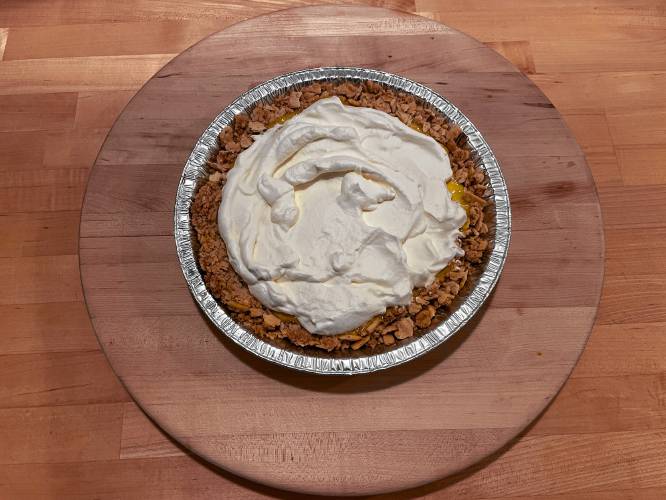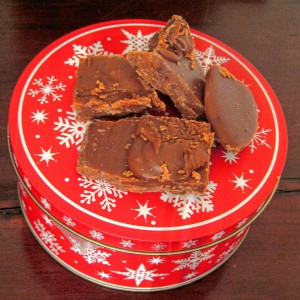Vacation in a pie: Atlantic Beach Pie was invented to be eaten at the end of a fish or seafood feast
| Published: 08-20-2024 12:23 PM |
Sometimes it’s impossible not to follow trends. Lately, I have seen recipes popping up all over the place for Atlantic Beach Pie. I met this pie first in the New York Times. It has also graced Southern Living magazine, NPR, and Forbes magazine, not to mention numerous food blogs. I finally gave in and baked one of the darn things.
Atlantic Beach Pie was popularized by Bill Smith, the chef who presided over a restaurant called Crook’s Corner in Chapel Hill, North Carolina, for a quarter of a century. It’s a kissing cousin to my favorite summer pie, Key Lime. Like Key Lime, this pie is a snap to make.
Instead of using key-lime juice, it opts for more potent lemon juice. (Some people prefer a mixture of lemon and lime, but I’m a purist, and so is Bill Smith, apparently.) And in place of graham-cracker crumbs, it uses lightly crushed saltines to create its crust.
I was skeptical when I first saw the recipe. It’s hard to top the subtle citrus flavor of key limes. Moreover, I tend to think of saltines as bland.
Nevertheless, I was intrigued by an article written by Bill Smith in a North Carolina magazine titled “Our State” in which he explained the rationale behind both the lemon juice and the saltines.
He claimed that the pie was ideal at the end of a fish or seafood feast. “When I was growing up in New Bern in the ‘50s, people believed as absolute truth that if you ate dessert after a meal of seafood, you would probably die,” he wrote.
This might be a slight exaggeration, yet my mother got very sick in her late teens when she dined on lobster and decided to follow that treat with ice cream. The double dose of richness made her feel as though she might indeed die.
Smith said that the exception to the “no dessert with seafood” rule in his youth was always lemon pie. Lemon toned down fish or seafood. If the pie was Atlantic Beach Pie, the seafood was further offset by the saltines, which were less sweet than a traditional graham-cracker crust.
Article continues after...
Yesterday's Most Read Articles
The sodium content of the saltines also evoked the saltiness of the sea. In the New York Times, Mia Leimkuhler claimed that the pie “tastes like a vacation.”
She wasn’t wrong. The lemon flavor is bright and festive. This pie won’t replace key lime in my repertoire, but it will be added to that repertoire.
Before I get to the recipe, I need to share some feedback I received about my recent article honoring National Coffee Milkshake Day. Several readers took me to task about my dismay when I learned that Friendly’s Fribble used to be known as an “Awful Awful.”
Beth Costello informed me that her grandfather, who lived in Montclair, New Jersey, came up with the term “Awful Awful.”
She wrote that the words were a code for something like “Awful Thick, Awful Good.” She added that Friendly’s only changed the name of its shake when it was sued by a rival company that had used the name first.
Robert McGahan believes that the name stood for “Awful Big, Awful Good.” He remembers consuming delightful Awful Awfuls at Snow’s Dairy Bar on School Street in Greenfield.
Marcia Edmonds didn’t object to my denigration of the term “Awful Awful.” She complained in an email, “The person who came up with that name should go hoe a potato field!” Instead, she took issue with my equating the meanings of the words “frappe” and “milkshake.”
“A frappe, though similar, is very thick and uses more ice cream (never a bad thing),” she wrote. “It’s nearly impossible to use a straw to drink a frappe, which is why they were usually served with a long iced-tea spoon.”
Since the term “frappe” is mainly confined to New England, I will have to do further research in other states to see how they differentiate between thick and not-so-thick shakes.
I have recently learned that Rhode Islanders make neither milkshakes nor frappes. They use the term “Cabinet,” perhaps because a blender is usually kept in a kitchen cabinet.
If my research includes tasting lots and lots of beverages involving milk and ice cream, I’m resigned to that fate. We writers must suffer for our art.
Meanwhile, here is the recipe for Atlantic Beach Pie. I must admit that I may have followed Bill Smith’s caution not to pulverize the saltines a bit too enthusiastically. The beach represented by my pie seemed to be made of large pebbles rather than sand.
No one seemed to mind. I shared the pie with my friends Peter and Ken and asked them to keep the leftovers. The next day Peter informed me that since the pie was associated with vacations, he had decided to pretend he was on vacation and eat pie for breakfast. He found his breakfast delicious.
Ingredients:
for the crust:
1-1/2 sleeves saltines (about 60 crackers)
(Make sure you get saltines that are topped with salt; apparently, they are available without the salt, which seems like a contradiction in terms.)
3 tablespoons sugar
1/2 cup sweet butter at room temperature
for the filling:
4 egg yolks
1 can (14 ounces) sweetened condensed milk
1/2 cup freshly squeezed lemon juice (or a mixture of lemon and lime juice)
for finishing:
sweetened whipped cream as needed
sea salt or lemon zest or mint leaves for garnish (optional)
Instructions:
Preheat the oven to 350 degrees. Place the crackers in a bowl, and crush them with your hands. They should be crumbled but not dust like. (You may also use a food processor to crush the crackers, but don’t over process them.)
Stir in the sugar; then knead the butter in with your hands until the crumbs mostly hold together. Press the crumb mixture into a 9-inch pie pan that can be moved from the refrigerator to the oven without breaking.
I used a foil pan just to be sure it wouldn’t have issues. When I transferred it to the oven later I put it inside a larger, metal pie pan to keep it stable.
Use the bottom of a measuring cup or a glass to press the crust down into the pan. Pop the crust in its pan into the refrigerator, and chill it for 15 minutes; then bake it for 18 minutes, or until it starts to have a little color. Remove it from the oven.
In a bowl, mix the egg yolks and the condensed milk, and whisk in the lemon juice. (Pouring the lemon juice into the milk can before adding it helps extract the goopy dregs.) Make sure the mixture is completely blended. Pour it into the pie shell, and bake for 15 to 20 minutes, until the filling has just about set.
Remove the pie from the oven, and let it come to room temperature. Spread a layer of whipped cream on top of the room-temperature filling and then freeze the whole thing until about 20 minutes before you want to serve it. It really doesn’t take long to defrost, and keeping it very cold ensures that the crust slices well.
You may also refrigerate or freeze the filling without the whipped cream and dollop on the cream when you’re serving the pie.
If you wish, add a little lemon zest, a mint leaf, or a sprinkle of sea salt to each slice to dress your pie up a little. Serves 6 to 8.
Tinky Weisblat is an award-winning cookbook author and singer known as the Diva of Deliciousness. Visit her website, TinkyCooks.com.








 Putting the students front and center: What can education can look like without high stakes testing?
Putting the students front and center: What can education can look like without high stakes testing? Sounds Local: He’ll play anything you want: Stephen Kellogg will perform an all-request show at Shea Theater, Dec. 19
Sounds Local: He’ll play anything you want: Stephen Kellogg will perform an all-request show at Shea Theater, Dec. 19 Speaking of Nature: Introducing the Birch Perch II: Making improvements to my bird observation venue
Speaking of Nature: Introducing the Birch Perch II: Making improvements to my bird observation venue Conversations over candy-making: Sharing beloved holiday food traditions
Conversations over candy-making: Sharing beloved holiday food traditions
